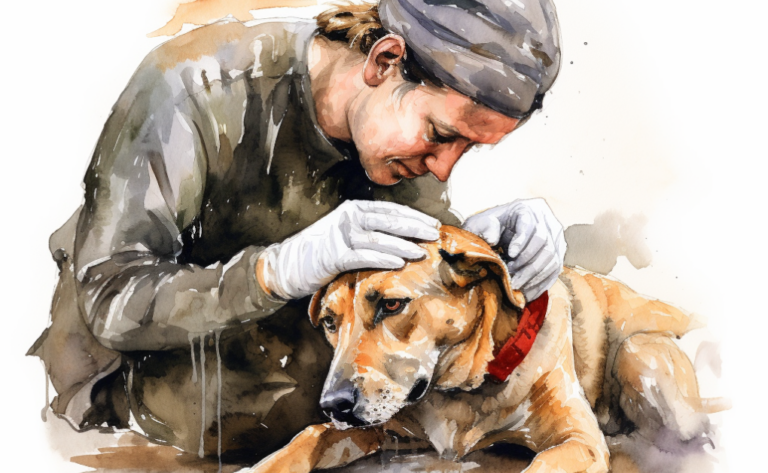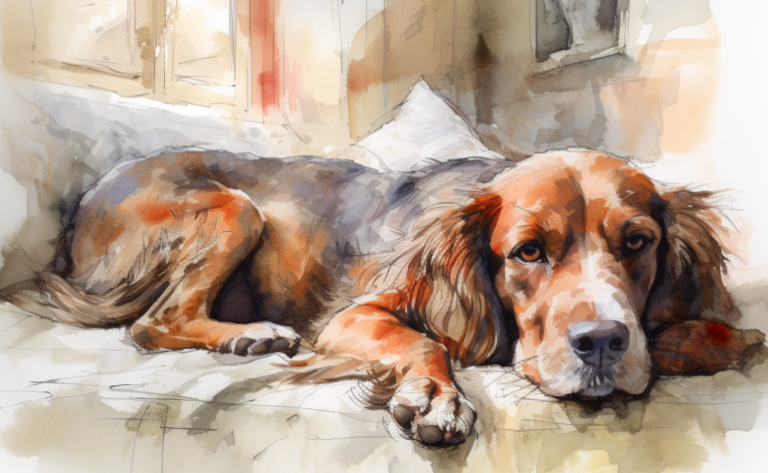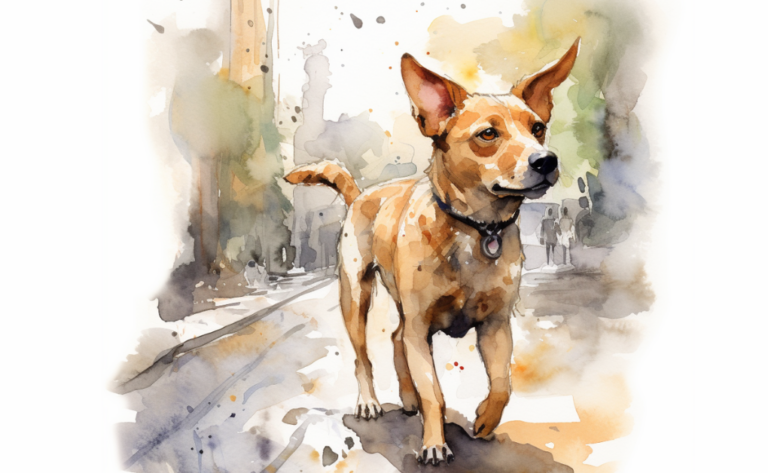15 Canine Skin Masses: What You Need To Know
What is it?
How is it Treated?
Breed Predispositions
There is no specific breed predisposition to skin masses in dogs. However, factors such as genetics, age, and exposure to toxins or environmental hazards may increase the risk of skin masses in some dogs.
Introduction
For years, Rachel and her fluffy Samoyed, Snowball, had been the best of friends, sharing countless memories together. One day, as Rachel was giving Snowball a much-needed brushing, she felt an unusual lump beneath the dog’s thick fur. Startled, she examined the area more closely, revealing a concerning skin mass. Knowing that her beloved pet’s health could be at stake, Rachel immediately sought the advice of her trusted veterinarian.
Skin lumps or masses are irregular formations that may surface on or beneath a dog’s skin. They are common in dogs across all breeds and ages, including the Labrador Retriever, and can present a wide range of variations in size, shape, and color. Many of these skin masses are benign or non-cancerous, such as lipomas, which are soft, fatty lumps typically posing no harm – in fact, 60-80% of these skin masses in dogs fall into the benign category.
However, on the other hand, some tumors may be malignant or cancerous, such as mast cell tumors or melanomas. These pose a significant health risk, particularly for dogs with short coats, if they are not promptly diagnosed and treated. For this reason, it is crucial that a veterinarian promptly evaluates any new or changing skin lumps to determine the most appropriate course of action.
Common Skin Masses in Dogs
Skin masses in dogs can be of several types, including but not limited to:
1. Lipomas
Lipomas are benign fatty tumors in dogs, especially older or overweight animals. These growths are made up of fat cells and are typically soft, round, or flat and can vary in size. They often appear just under the skin and are usually movable when touched. Lipomas can occur anywhere on the body but are most commonly found on the chest, abdomen, and limbs. While these tumors are non-cancerous and usually cause no harm, they can occasionally interfere with a dog’s movement or function, depending on their size and location.
2. Sebaceous Cysts
Sebaceous, epidermal, or follicular cysts are small bumps in dogs. These cysts form in the sebaceous glands, the glands in the skin that secrete an oily substance called sebum that lubricates the skin and fur.
A sebaceous cyst is essentially a sac filled with sebum. These cysts can develop due to blockage of the gland’s duct, leading to an accumulation of sebum. Sebaceous cysts can occur anywhere on the body but are most commonly found on the head, neck, and trunk.
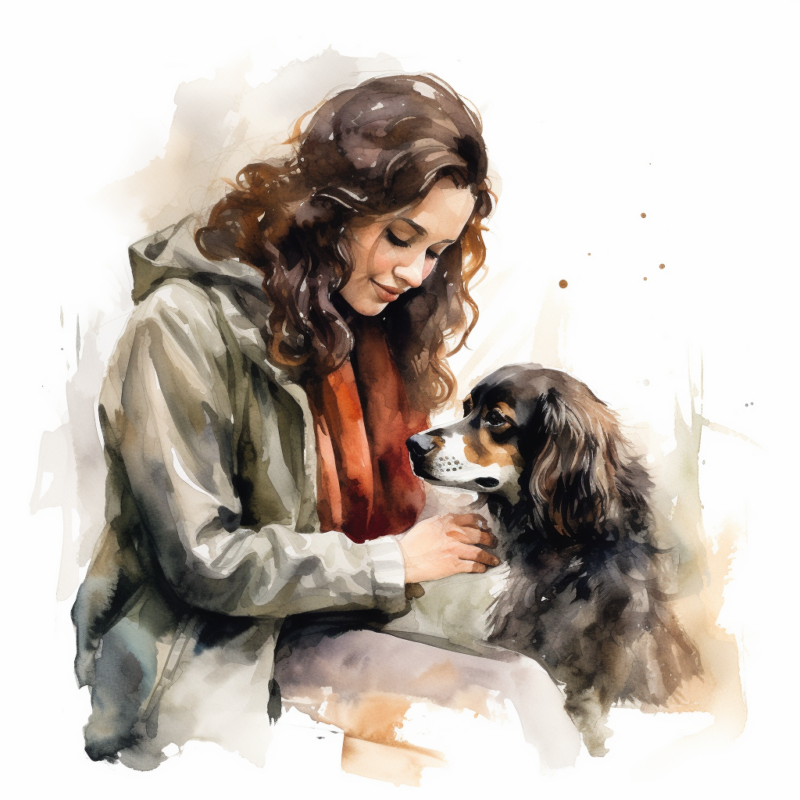
These cysts are usually benign (non-cancerous) and cause no harm unless they become infected or inflamed, which can lead to discomfort for the dog. If a cyst ruptures, it can cause a local inflammatory response or infection that requires veterinary treatment. While the benign sebaceous are not dangerous, their presence can sometimes indicate underlying issues such as hormonal imbalances or skin infections.
3. Histiocytomas
Histiocytic cell tumors are benign (non-cancerous) skin tumors in dogs, particularly young dogs under three years old. These growths originate from cells known as histiocytes, a type of immune cell found in the skin that plays a crucial role in the body’s immune response.
Histiocytomas are typically present as small, firm, raised, hairless, and sometimes ulcerated bumps. While they can occur anywhere on the body, they are most commonly found on the head, ears, and limbs. Despite their sudden and often alarming appearance, histiocytomas are usually not painful or itchy for the dog unless they become infected or inflamed.
One notable characteristic of histiocytomas is that they often resolve spontaneously without treatment within a few months. However, any new skin growth on a dog should be evaluated by a veterinarian to rule out other more serious conditions, such as malignant tumors.
4. Mast Cell Tumors
Mast cell tumors (MCTs) are one of the dogs’ most common types of skin cancer. They originate from mast cells, part of the dog’s immune system. Mast cells are found throughout a dog’s body and are critical in allergic responses. They contain granules filled with substances that can be released into the body, leading to allergic reactions.
In dogs, MCTs can range widely in appearance, size, and growth rate. They might appear as small, barely noticeable bumps or large, ulcerated masses. They can be found anywhere on the dog’s body, but they are most commonly found on the skin, especially on the limbs, lower abdomen, and chest.
MCTs in dogs can vary greatly in their level of malignancy. Some may be relatively benign and cause minimal problems, while others can be very aggressive, spread rapidly, and cause severe health issues. The exact cause of MCTs is unknown, but some breeds are more prone to them than others, suggesting a genetic component.
5. Hematomas
A hematoma in dogs is a localized blood collection outside the blood vessels. It is often a response to injury or trauma to the body that causes blood vessels to break. As a result, the blood leaks into the surrounding area and clots, forming a lump or swollen area. Hematomas can occur in various parts of the dog’s body, but they are commonly seen in the ear flaps (aural hematomas), skin (subcutaneous hematomas), and internal organs.
An aural hematoma, one of the most common types in dogs, typically results from head shaking or vigorous ear scratching that ruptures small blood vessels in the ear flap. As a result, it is a swollen, fluid-filled ear flap and can cause significant discomfort.
Subcutaneous hematomas can result from trauma or injury to the skin and underlying tissue. They present as localized swelling or a lump under the skin.
Internal hematomas can occur in organs like the spleen, liver, or kidney due to trauma or as a complication of diseases that cause clotting abnormalities. These can be more serious or life-threatening and require immediate veterinary attention.
Treatment of hematomas often involves addressing the underlying cause and may include surgical or medical intervention to remove or resolve the hematoma.
6. Papillomas
Papillomas, often called “warts,” are small, benign (non-cancerous) tumors caused by the papillomavirus in dogs. They are common in canines and typically affect the skin and mucous membranes. These growths are usually round and have a cauliflower-like appearance. They may appear as a single growth, or there can be multiple in one area.
Although they often occur in older dogs, dogs can get a papilloma. However, dogs with weakened immune systems or frequently interacting with other dogs are at a higher risk, as the virus can be spread through direct contact or shared objects like toys or bedding.
While these warts are usually harmless and often disappear independently, in rare cases, they may cause discomfort or become infected. In such instances, or if the papillomas become very large or grow in areas that interfere with the dog’s daily functions, they may require removal. A vet should always check any growth on your dog to rule out more serious conditions.
7. Melanomas
Melanomas in dogs are a type of cancer that develops from melanocytes, the cells responsible for pigmentation in the body. These tumors are often dark in color due to the melanin in the cells, but not always. They can occur in areas of the body with hair but are more commonly found in the mouth or mucous membranes. They can also develop in the nail beds of the paw.
Melanomas vary greatly in their behavior. Cutaneous (skin) melanomas in dogs are often benign. In contrast, oral melanomas tend to be malignant, with a high likelihood of spreading (metastasizing) to other areas of the body, particularly the lymph nodes and lungs. Therefore, the prognosis for dogs with melanoma greatly depends on the location and extent of the disease at the time of diagnosis.
As with any cancer, early detection and treatment are key. A vet should evaluate any new or changing growths in a dog. Treatment typically involves surgical removal of the tumor and may also include radiation therapy, chemotherapy, or immunotherapy, depending on the severity and location of the melanoma.
8. Abscesses
Dogs’ Abscesses are localized pus collections that occur due to an infection. They can form anywhere in a dog’s body, including the skin, mouth, between the toes, or within body cavities. However, they are typically the result of a bacterial infection that occurs when the skin barrier is broken due to a bite, wound, or foreign object, allowing bacteria to invade the underlying tissue. Once the bacteria are introduced to the site, the dog’s immune system responds, and white blood cells begin to fight the infection, accumulating pus.
Abscesses can cause a variety of symptoms depending on their location. Commonly, they can cause pain, swelling, and redness and may feel warm to the touch. In addition, abscesses close to the skin may rupture, releasing a discharge of pus.
9. Squamous Cell Carcinomas
Squamous cell carcinomas (SCCs) are a type of cancer originating in the squamous cells found in the skin and the lining of body organs. These cells form the outer layer of the skin, the mouth, throat, and digestive tract lining, and the respiratory and reproductive systems.
In dogs, squamous cell carcinomas are commonly found in areas with little hair, such as the belly and the legs, but they can occur anywhere, including the mouth and the nail beds. These tumors are often caused by long-term exposure to the sun; thus, dogs with light skin or thin coats are at a higher risk.
Squamous cell carcinomas can grow quickly, causing skin lesions, sores, or growths that may ulcerate and become infected. The tumors can also be invasive, spreading to surrounding tissues and occasionally to other body parts, such as the lymph nodes or lungs.
10. Basal Cell Tumors
Basal cell tumors are skin cancer arising from the basal cells located in the deepest epidermis layer (skin) and around hair follicles. These tumors are most commonly found in middle-aged to older dogs.
Basal cell tumors in dogs are often benign, meaning they do not typically spread to other body parts. Instead, they appear as solitary lumps on the skin that are firm and well-defined and may vary in size. While these tumors can develop anywhere on the body, they are most commonly found on the head, neck, and shoulders.
It’s not entirely clear why these tumors develop, but genetic factors and long-term sun exposure may play a role. When detected early, these tumors can often be successfully removed with surgery. However, if left untreated, they can grow larger and become more difficult to remove, but they tend not to spread (metastasize) to other areas.
As with other skin cancers, minimizing sun exposure and regularly checking your dog’s skin for new or changing lumps can help early detection and treatment. If you notice anything unusual, it’s important to get it checked out by a veterinarian.
11. Fibrosarcomas
Fibrosarcomas are a type of malignant tumor arising from fibroblast cells in dogs, which produce collagen and other fibers that provide structural support and elasticity in the body’s tissues. They can occur anywhere in the body but are commonly found in the skin and subcutaneous tissues.
These tumors grow slowly but are locally invasive, meaning they can invade and damage surrounding tissues. As a result, they’re less likely to metastasize or spread to other body parts than other types of cancer, although metastasis can occur in some cases.
Fibrosarcomas are often seen as firm, raised lumps on the skin, but because they can grow inwards and invade deep tissues, they may not always be noticeable from the outside.
Treatment typically involves surgical removal of the tumor and may also involve radiation therapy or chemotherapy, depending on the severity and location of the tumor. Prognosis can vary greatly depending on these factors as well.
As with other types of cancer, regular vet check-ups and monitoring your dog for any changes in behavior or physical appearance can help catch these conditions early, improving the chances for successful treatment.
12. Epitheliotropic Lymphoma (Mycosis Fungoides)
Epitheliotropic lymphoma, also known as cutaneous T-cell lymphoma or mycosis fungoides, is a type of skin cancer in dogs that affects T lymphocytes, a type of white blood cell that plays a crucial role in the immune system. In this condition, abnormal T lymphocytes proliferate and invade the skin (epidermis), causing various skin lesions.
The disease typically presents with skin abnormalities such as scaling, redness (erythema), plaques, ulcers, and nodules. These can appear anywhere on the body, but the groin, armpits, and areas around the mouth and eyes are most commonly affected. In addition, the disease is progressive and can eventually involve the internal organs if left untreated.
Treatment options often involve a combination of topical and systemic treatments, such as corticosteroids, retinoids, or chemotherapy agents, as well as radiation therapy. The prognosis varies widely, depending on the stage of the disease at diagnosis, and can range from months to years.
As always, regular veterinary examinations and paying attention to changes in your dog’s skin or behavior can help detect this and other conditions early, providing the best chances for effective treatment.
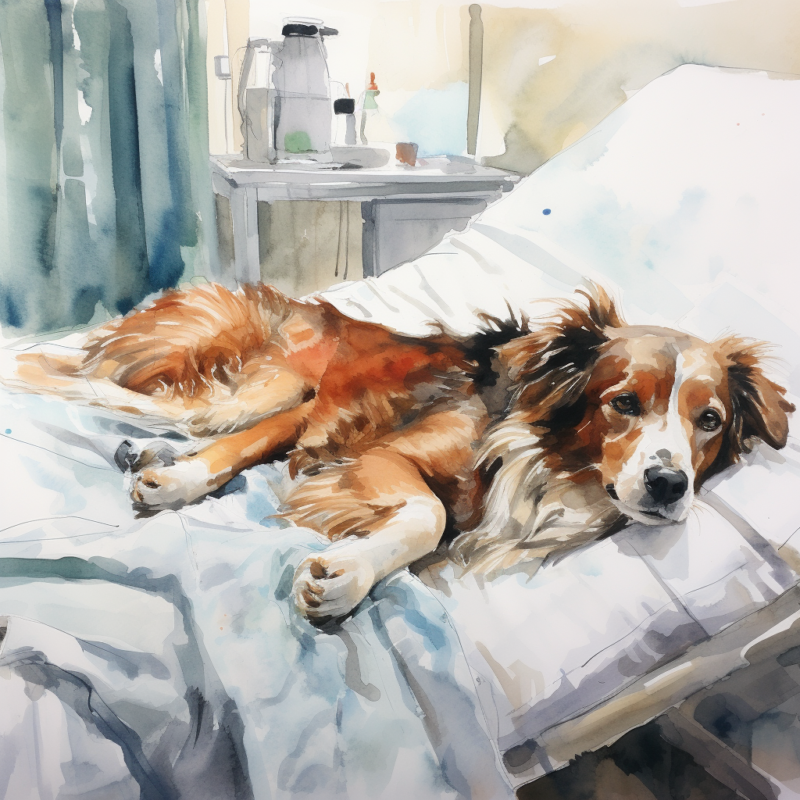
13. Skin Adenomas
Skin adenomas, also known as sebaceous gland adenomas, are benign tumors originating from the sebaceous glands of a dog’s skin. Sebaceous glands are small oil-producing glands in the skin all over the body. They play an important role in skin health by secreting sebum, which helps protect and moisturize the skin.
These glands can form a sebaceous adenoma when undergoing abnormal cell growth. These tumors appear as small, elevated nodules on the skin surface, often with a cauliflower-like appearance. They can vary in color, often appearing flesh-colored, and can be single or multiple. Adenomas are most common in older dogs, and certain breeds may be more susceptible.
Although sebaceous gland adenomas are benign and not life-threatening, they can become irritating or infected, especially if they are located in areas that the dog can scratch or bite. If this happens, or if the adenoma grows quickly or changes in appearance, a veterinarian may recommend removal.
Despite being benign, any new growths on your dog’s skin should be evaluated by a veterinarian to rule out more serious conditions. Regular check-ups and promptly addressing changes in your dog’s skin can help ensure your pet stays healthy.
14. Skin Tags (Acrochordons)
Skin tags, also known as acrochordons or fibroepithelial polyps, are small, benign growths that can occur in dogs. They often appear as thin stalks or bumps with a fleshy or slightly wrinkled surface. Skin tags can vary in color from flesh-colored to dark brown or black.
Skin tags are composed of both skin cells and fibrous tissue, and they typically develop in areas where the skin forms, creases or rubs together, such as the armpits, groin, and neck, although they can appear anywhere on the body.
Although skin tags are harmless, they can be confused with more serious skin conditions, including malignant tumors. For this reason, any new skin growth on a dog should be evaluated by a veterinarian. In addition, if a skin tag becomes irritated or changes in appearance, it may need to be removed. The procedure is typically simple and can often be performed under local anesthesia.
15. Sarcoptic Mange
Sarcoptic mange, also known as canine scabies, is a highly contagious skin disease caused by the Sarcoptes scabiei mite. These microscopic mites burrow into the dog’s skin and cause intense itching or pruritus, leading the dog to scratch relentlessly and bite at the skin. This can result in hair loss, skin inflammation, and secondary skin infections.
Sarcoptic mange is spread by direct contact with an infected animal, including wildlife, or through contaminated objects like bedding. The mites can survive for a short time in the environment, but direct contact is the primary transmission mode.
The disease is only sometimes easily recognizable because the mites are hard to find on skin scrapings, one of the usual diagnostic methods. Sometimes a presumptive diagnosis is made based on clinical signs and response to treatment. Various treatments exist, including medicated shampoos, dips, injections, and oral medications.
Sarcoptic mange can also affect humans, causing a rash and itching, so care should be taken when handling an infected dog. Although challenging, most dogs fully recover with effective and thorough treatment.
Causes of Skin Masses in Dogs
The root causes of skin lumps, or skin masses, in dogs can vary widely depending on the type of tumor. Here is an overview of the potential sources:
- Genetic Factors: Certain canine breeds possess a heightened risk for specific types of skin masses. For instance, Boxers and Boston Terriers are more prone to mast cell tumors, a form of skin cancer commonly found in dogs. On the other hand, sebaceous gland tumors are frequently seen in Cocker Spaniels.
- Age-Associated Factors: Skin masses tend to escalate with age. Older dogs are more vulnerable due to their bodies’ diminished capacity to rectify cellular damage.
- Solar Exposure: Prolonged exposure to the sun can instigate the growth of certain skin masses, such as squamous cell carcinomas, that manifest as cancerous lumps. Dogs with light-colored or sparse coats are especially susceptible to these tumors.
- Infections and Immune Responses: Certain skin lumps, including histiocytomas or papillomas (warts), may arise due to viral infections or immune system activities. These types of tumors are generally linked to infections or immune responses.
- Hormonal Influences: Hormonal changes can also spur the formation of skin masses. For example, non-spayed female dogs may develop mammary tumors due to the effects of estrogen and progesterone levels.
- Physical Trauma or Constant Irritation: Skin regions exposed to injury, chronic irritation, or inflammation may produce skin masses as the body endeavors to heal the damage. This is a common skin area where tumors are more likely to appear.
- Environmental Exposure: Dogs exposed to certain chemicals or toxins might have a heightened risk of developing particular types of skin masses.
Despite these potential causes, it’s essential to acknowledge that the exact cause behind many skin lumps in dogs often remains unclear. Thus, a regular schedule of veterinarian check-ups to oversee any skin masses a dog might develop is essential. Early detection and diagnosis of any tumor type, even if not common in cats but found in dogs, can significantly improve the prognosis for many skin masses.
Symptoms of Skin Masses in Dogs
Symptoms of skin masses, including tumors, often differ in dogs, contingent on factors such as the type of mass, its location and size, and whether it’s benign skin growth or a malignant tumor. However, common signs that may be observed include:
- A visible lump or protrusion raised above the skin or underlying tissues, noticeable on touch.
- Alterations in an existing lump, whether in size, color matching the skin or otherwise, or shape.
- Painful or sensitive masses upon touch.
- The occurrence of skin lesions, such as ulceration or bleeding from the mass.
- Itching sensations make the dog scratch, bite, or lick the mass.
- Hair loss in the area surrounding the mass.
- Behavioral modifications, including decreased appetite, lethargy, or changes in mobility, especially if the tumor hampers the dog’s movement.
- Complications in vital activities like breathing, eating, or defecation if the tumor occurs in a place that impedes these functions.
- Redness or swelling in the area immediately surrounding the mass, and possibly, the emergence of multiple growths in other areas of your dog’s skin.
It’s important to remember that some skin masses, or tumors in dogs, aren’t readily visible, particularly in breeds with dense or long hair. However, routinely petting and grooming your pet can aid in detecting unusual lumps or growths early. If you notice any of these symptoms or discover a new mass anywhere on your dog’s skin, immediate consultation with a veterinarian is crucial for precise diagnosis. This becomes particularly important when considering that tumors diagnosed in dogs can sometimes be a form of skin cancer.
Diagnosis of Skin Masses in Dogs
Veterinarians use several methods to diagnose skin masses in dogs. Here’s the typical process:
Physical Examination
Physical examination is a crucial first step in diagnosing skin masses in dogs. Here’s what this process generally entails:
- Initial Observation: The vet will first visually inspect your dog’s skin for any visible lumps, bumps, or masses. They’ll also look for signs of redness, swelling, or other abnormalities.
- Palpation: The vet gently feels your dog’s skin and underlying tissues. By doing this, they can assess detected masses’ size, shape, and consistency. They will also note if the mass is fixed or movable, which can help differentiate between benign and potentially malignant growth.
- Location Identification: The location of the mass can provide valuable information about its nature. For example, masses in areas where your dog has been vaccinated could be vaccine-related.
- Assessment of Multiple Masses: If your dog has multiple skin masses, the vet will check each one. Multiple skin masses could indicate a systemic issue or a condition that causes multiple benign growths.
- Skin Condition: Apart from the mass itself, the vet will assess the overall condition of your dog’s skin. Conditions like dermatitis, skin infections, or allergies could cause skin masses.
- Pain Assessment: The vet will determine if the mass is causing your dog any discomfort or pain, which can indicate the mass’s nature.
- Lymph Node Check: The vet may also check the lymph nodes near the location of the skin mass. Swollen lymph nodes can indicate that the body is fighting an infection or could potentially indicate the spread of a malignant tumor.
Remember, a physical examination alone cannot definitively diagnose the type of skin mass. Further diagnostic tests such as a biopsy, cytology, or imaging may be required.
History Taking
When diagnosing skin masses in dogs, taking a detailed history is a critical step in the process. Here’s what a veterinarian will typically cover during history taking:
- The onset of the Mass: The vet will ask when you first noticed the mass on your dog’s skin. The speed at which a mass has appeared and grown can give some indication as to its nature.
- Changes in the Mass: You’ll be asked if the mass has changed in size, shape, color, or texture over time. Rapid changes could suggest a more serious condition, such as a malignant tumor.
- Behavioral Changes: The vet will inquire about any behavioral changes in your dog, such as loss of appetite, lethargy, changes in bowel movements, or signs of pain or discomfort.
- Previous Health Issues: Understanding your dog’s overall health history can be helpful. This includes previous skin masses, surgeries, health conditions, or reactions to certain medications.
- Vaccination History: Some skin masses can be associated with vaccination sites, so your vet will want to know about your dog’s vaccination history.
- Current Medications: If your dog takes any medication, it’s important to inform the vet. Certain medications can lead to skin changes or growth.
- Exposure to Other Animals: This could be relevant if your dog has been around other dogs or animals with skin masses or infectious diseases.
- Environment: Your dog’s environment can also play a role in developing skin masses. Factors such as exposure to sun, chemicals, or certain plants can contribute to skin issues.
Remember, this information is a part of the diagnosis process and helps the vet to decide what further tests may be necessary to confirm the nature of the skin mass.
Biopsy
A biopsy is a more invasive diagnostic procedure than a fine-needle aspiration (FNA), but it can offer a more detailed analysis of common skin tumors in dogs. During a biopsy, a larger portion of the mass, or sometimes, the entire mass that may be affecting the skin or confined to the skin, is extracted for a thorough examination. Here’s the general process:

- Preparation: To ensure your pet’s comfort and allow for meticulous surgical methods, biopsies are typically conducted under general anesthesia or, in certain cases, local anesthesia.
- Procedure: The veterinarian will make a surgical incision and extract a small fragment of the mass (an “incisional biopsy”) or the whole mass (an “excisional biopsy”). Factors like the mass’s size, location, and suspected type determine the choice between these methods.
- Examination: The extracted tissue sample is dispatched to a laboratory for histopathological review. Under a microscope, a veterinary pathologist will scrutinize the tissue sample to discern the cell type and seek signs of malignancy or other abnormalities.
A biopsy can yield definitive information about a skin mass, especially valuable if the mass is suspected to be malignant. However, being a more invasive procedure, it may involve more risks than FNA, including potential complications from anesthesia, bleeding, or infection at the incision site. Therefore, your vet will always deliberate on the best diagnostic approach for your dog’s situation, considering all potential problems.
Fine-Needle Aspiration (FNA)
Fine-Needle Aspiration (FNA), also known as a fine-needle biopsy, is commonly employed procedure vets use to investigate dog skin tumors. This minimally invasive method involves using a thin, hollow needle to gather cells from the mass. Here’s the general procedure:
- Preparation: Depending on the mass’s size, location, and the dog’s disposition, a local anesthetic might numb the area. However, many FNAs are performed without anesthetic as the procedure is fast and causes minimal discomfort.
- Procedure: The vet will pierce the skin mass with a fine needle and shuffle it back and forth several times to collect a cell sample. The vet may use a syringe to create suction if the mass is solid, helping collect cells into the needle.
- Examination: The obtained cells are smeared onto a microscope slide and sent to a lab for cytological review. A veterinary pathologist will inspect the sample under a microscope to identify the cell type and look for signs of inflammation, infection, or malignancy.
FNA is a useful diagnostic tool because it’s quick, generally well-received by dogs, and can often provide valuable information about the mass nature. It should be noted, though, that FNA may not always provide a definitive diagnosis. Additional diagnostic tests may be required, such as a full surgical biopsy.
Imaging
Imaging offers another crucial tool for diagnosing skin masses in dogs. Various imaging techniques may be used, each with its unique advantages and applications:
- Radiographs (X-rays): X-rays can help ascertain if a skin mass invades underlying structures like bones or large vessels. This technique also aids in identifying any spread (metastasis) of a suspected cancerous mass to the lungs or other internal organs.
- Ultrasound: Ultrasound uses sound waves to generate images of the body’s internal structures. It can be useful for examining the extent of a mass beneath the skin surface or guiding an FNA or biopsy.
- Computed Tomography (CT) or Magnetic Resonance Imaging (MRI): These advanced imaging techniques provide detailed, cross-sectional body views. They can be especially beneficial in assessing a mass’s size, location, and extent, which can be crucial if surgical removal is contemplated.
- Nuclear Scintigraphy: This imaging technique involves injecting a small amount of radioactive material into the body, which accumulates in areas with increased metabolic activity, such as a tumor. A special camera is then used to detect the radiation and create an image. This can be useful in some cases for detecting cancer spread to other body parts.
It’s worth noting that tumors affecting the skin are commonly found in certain breeds, and some dogs are more likely to develop them than others. For instance, skin tumors are the most common type of tumor in Labrador Retrievers. Therefore, regular check-ups are vital for early detection and successful treatment regardless of breed.
Blood Tests
Blood tests are an important part of diagnosing skin masses in dogs. They can provide valuable information about a dog’s overall health, which may impact the treatment plan for a skin mass. They can also sometimes provide clues about the nature of the mass itself. Here are a few of the common blood tests used:
- Complete Blood Count (CBC): This test provides information about the different cells in the blood, including red blood cells, white blood cells, and platelets. It can help detect conditions like anemia or infection, which might indicate underlying problems or affect how a dog responds to treatment.
- Serum Biochemical Profile: This test measures various chemicals and enzymes in the blood. It can provide information about the function of various organs, like the liver and kidneys, which may be affected by a cancerous mass or its treatments.
- Coagulation Profile: This test measures how well the blood is clotting. Cancers can sometimes cause abnormal clotting and may affect surgical plans.
- Cytology and Histopathology: If a fine-needle aspiration or biopsy of the mass is performed, the collected cells or tissue will be examined under a microscope. This can often provide definitive information about the type of mass, whether benign or malignant.
- Cancer markers: In some cases, blood tests for specific markers of certain types of cancer might be recommended. These tests are still not commonly used in veterinary medicine, but research is ongoing.
It’s important to note that while blood tests can provide valuable information, they cannot definitively diagnose a skin mass. Therefore, they are usually used with other diagnostic tools like a physical examination, fine-needle aspiration or biopsy, and imaging.
It’s important to note that while some skin masses can be diagnosed with a high degree of confidence based on FNA or biopsy, the only way to be 100% certain of the type of mass is to remove it entirely and send it for histopathology.
Treatment for Skin Masses in Dogs
The treatment options for skin masses in dogs depend largely on the type and location of the mass, as well as the overall health of the dog. Here are some potential treatment options:
Surgical Treatment of Skin Masses in Dogs
Surgical intervention often remains the primary line of treatment for skin masses in dogs, particularly when the masses are suspected to be malignant or are causing discomfort to the pet. The main goal of surgical resection is to eliminate the entire mass and a margin of healthy tissue, thereby eradicating all abnormal cells. Here’s a brief walkthrough of what this procedure might entail:
- Pre-surgical Evaluation: Before the surgical excision, the veterinary surgeon will usually conduct various tests, including blood analysis, to ascertain your dog’s health status and its ability to withstand anesthesia and the surgical procedure. Imaging tests may also evaluate the mass and plan the surgery strategically.
- Anesthesia: To ensure that your dog remains pain-free and stationary during the operation, general anesthesia is administered for all surgical procedures intended for removing skin masses.
- Surgical Excision: An incision is made by the surgeon surrounding the mass to excise it along with a margin of healthy tissue. The size of the healthy tissue margin depends on the type of mass and its suspected malignancy.
- Histopathology: The mass is typically dispatched to a veterinary pathologist post-removal. They will scrutinize the mass under a microscope to validate the type of mass and to ensure that the margins of the extracted tissue are devoid of abnormal cells.
- Postoperative Care: Post-surgery, your dog will require time to recuperate. This period may include pain management, wound care, and possibly antibiotic administration to prevent infections. Moreover, preventing your dog from licking or scratching the surgical site is crucial, which might necessitate an Elizabethan collar.
- Follow-up: The veterinary surgeon will schedule follow-up appointments to track your dog’s recovery, remove necessary stitches, and discuss the histopathological results. Other treatment strategies, such as chemotherapy or radiation therapy, may be proposed for malignant masses.
While the surgery entails risks associated with anesthesia, infection, and incomplete mass removal, it frequently offers the best chance to treat dog skin masses effectively. The prognosis post-surgery hinges on the type of mass, the success of its complete removal, and whether it has metastasized to other body parts.
It’s worth mentioning that some dogs, such as Golden Retrievers, often develop these tumors. Even benign melanoma, a relatively common tumor type, requires careful attention. Therefore, regular check-ups and monitoring of any area of the skin are vital. It is also advisable to consider pet insurance to cover potential surgical and treatment costs.
Chemotherapy for Skin Masses in Dogs
Chemotherapy is often employed as a treatment option for dogs with malignant skin masses, particularly if the cancer has spread (metastasized) to other body parts. It may also be used after surgical removal of a mass to kill any remaining cancer cells and reduce the risk of recurrence. Here’s an overview of chemotherapy treatment for skin masses in dogs:
- Objective of Chemotherapy: The goal of chemotherapy in dogs, like humans, is to kill cancer cells. However, the focus in veterinary medicine is usually on maintaining the quality of life rather than on achieving a cure. Therefore, the dosages of chemotherapy drugs used in dogs tend to be lower than those in human medicine, which helps to limit side effects.
- Types of Chemotherapy Drugs: Various drugs can be used in chemotherapy, and the choice depends on the type of cancer, the dog’s overall health, and the specific treatment goals. Some drugs are administered orally, while others are given by injection.
- Treatment Schedule: Chemotherapy is often given in cycles, with each period of treatment followed by a recovery period. The length of treatment varies depending on the type of cancer and the dog’s response to the medication.
- Side Effects: Although the goal is to limit side effects as much as possible, some dogs may experience symptoms such as nausea, loss of appetite, vomiting, diarrhea, or tiredness. Most side effects are temporary and can be managed with additional medications.
- Monitoring: Regular check-ups will be needed to monitor your dog’s response to treatment and adjust the chemotherapy protocol if necessary. This may involve blood tests, physical examinations, and possibly imaging tests.
- Prognosis: The effectiveness of chemotherapy varies widely depending on the type and stage of cancer, the dog’s overall health, and the specific treatment protocol. Some dogs respond very well to treatment, while others may not. Your vet will discuss the likely outcomes and potential risks before starting treatment.
It’s important to note that while chemotherapy can be very effective, it’s not the right choice for every dog or every situation. Your vet will consider all the factors and discuss the options with you to make the best decision for your pet’s health and quality of life.
Radiation Therapy for Skin Masses in Dogs
Radiation therapy is another potential treatment for skin masses in dogs, particularly when surgical removal is not an option or if the tumor is likely to recur after surgery. Here’s an overview of radiation therapy treatment for skin masses in dogs:
- Objective of Radiation Therapy: Radiation therapy aims to damage and destroy cancer cells in the targeted area while minimizing harm to surrounding healthy tissues. Radiation can be curative or palliative in intent. Curative radiation eliminates cancer, while palliative radiation seeks to alleviate symptoms and improve the quality of life for dogs with advanced cancer.
- Procedure: Radiation therapy involves using high-energy X-rays or other types of radiation. The dog is usually placed under general anesthesia for each treatment session to ensure they remain still. The process itself is painless.
- Treatment Schedule: Radiation therapy is typically given in a series of treatments over several weeks, though the exact schedule can vary based on the type of tumor, its location, and the overall health of the dog.
- Side Effects: Radiation therapy can cause side effects, particularly in the treated area. These may include hair loss, skin redness, and irritation. In addition, long-term side effects could include fibrosis (scar tissue formation), color changes in the skin, and secondary cancers. However, these side effects are relatively rare, and your vet will take steps to minimize the risk.
- Monitoring: Regular follow-up appointments will be necessary to monitor your dog’s response to the treatment, manage side effects, and make any necessary adjustments to the treatment plan. This could include physical examinations, blood tests, and imaging studies.
- Prognosis: The success of radiation therapy varies widely depending on the type and stage of cancer, the dog’s overall health, and the specific treatment protocol. Some dogs respond very well to treatment, while others may not.
It’s important to discuss all treatment options, including their potential benefits and risks, with your vet to make the best decision for your pet’s health and well-being.
Cryosurgery for Skin Masses in Dogs
Cryosurgery, or cryotherapy, is a minimally invasive procedure for treating dog skin masses. This method uses extreme cold to freeze and destroy abnormal tissues, such as benign and malignant tumors. Here’s how it works:
- Objective of Cryosurgery: Cryosurgery is intended to kill tumor cells while effectively preserving the surrounding healthy tissue. It is often used for small, superficial skin masses and may be particularly beneficial for older dogs or those with other health conditions that make traditional surgery riskier.
- Procedure: A cryoprobe (a small, thin instrument) is applied directly to the skin mass during cryosurgery. Liquid nitrogen or argon gas is then used to freeze the tissue rapidly. Unfortunately, this rapid freezing and subsequent slow thawing process cause the cells to rupture and die.
- Treatment Schedule: Depending on the size and location of the mass, one or more cryosurgery sessions may be required. Each session typically lasts between a few minutes to half an hour.
- Side Effects: Cryosurgery is generally well-tolerated, but some dogs may experience minor discomfort, swelling, or redness at the treatment site. Temporary hair loss in the treated area is also common. In rare cases, nerve damage or skin ulceration can occur.
- Monitoring: Regular follow-up appointments will be necessary to check the treated area, assess healing, and monitor for any signs of recurrence.
- Prognosis: The success of cryosurgery largely depends on the type and size of the skin mass. While it can be very effective for small, superficial masses, larger or deeper tumors may still need to be fully eliminated and could require additional treatment.
It’s crucial to discuss with your vet whether cryosurgery is a suitable option for your dog’s skin mass, considering the type, size, location of the mass, and overall health.
Immunotherapy for Skin Masses in Dogs
Immunotherapy is an innovative treatment approach for skin masses in dogs, especially for certain types of cancerous tumors. This therapy harnesses the body’s immune system to fight against abnormal cells, promoting the destruction of the mass. Below is a detailed explanation of how immunotherapy works:
- Objective of Immunotherapy: Immunotherapy aims to stimulate the dog’s immune system to recognize and attack the abnormal cells in the skin mass while leaving healthy cells untouched. This offers a targeted approach with fewer side effects than traditional treatments like chemotherapy.
- Procedure: Immunotherapy usually involves administering specific drugs or vaccines to provoke an immune response. Depending on the specific treatment plan, these substances can be administered via injection, orally, or topically.
- Treatment Schedule: The frequency and duration of immunotherapy treatments depend on the specific type of immunotherapy used and the nature of the skin mass. Some therapies may require regular administration over weeks or months.
- Side Effects: Immunotherapy generally has fewer side effects than traditional cancer treatments. Possible side effects can include mild fever, fatigue, and injection site reactions. However, these are typically temporary and resolve once the body adjusts to treatment.
- Monitoring: Regular follow-up visits with your veterinarian will be necessary to monitor the response to treatment and adjust the therapy plan.
- Prognosis: The success of immunotherapy can vary widely and depends on factors like the type and stage of the skin mass, the overall health of the dog, and the specific type of immunotherapy used.
Remember, discussing all treatment options with your veterinarian or a veterinary oncologist to determine the best course of action for your dog’s specific condition is important.
Medication for Treating Skin Masses in Dogs
In some cases, medication may be an appropriate treatment method for skin masses in dogs, particularly when the mass is associated with an underlying condition that can be managed medically. Here’s an overview of the potential role of medication in this context:
- Antibiotics: Antibiotics may be prescribed to combat the infection if a skin mass is infected or abscessed. In some cases, resolution of the infection can lead to a reduction in the size of the mass.
- Anti-inflammatory Drugs: If the skin mass is causing discomfort, your vet may prescribe non-steroidal anti-inflammatory drugs (NSAIDs) to help reduce inflammation and relieve pain. Some types of skin tumors can also respond to this type of treatment.
- Hormone Therapy: For certain hormone-responsive tumors, your vet might prescribe medication to block the effects of those hormones, which can help to control the growth of the mass.
- Chemotherapeutic Agents: If the mass is malignant (cancerous), your vet may prescribe chemotherapy drugs to help control the spread of the disease. Chemotherapy can be given orally or by injection, and the type of drug, dosage, and treatment schedule will depend on the type and stage of the cancer.
- Immunomodulatory Drugs: Some skin masses may respond to drugs that modulate the immune system. These can include medications like cyclosporine or apoquel, often used for immune-mediated skin diseases.
Always remember that any medication should only be given under the guidance of a veterinarian. The type of medication, dosage, and duration of treatment will depend on the specific type of skin mass, your dog’s overall health, and other factors. Regular follow-ups with your vet will be necessary to monitor your dog’s response to the medication and to make any necessary adjustments to the treatment plan.
Every dog and every skin mass is unique so the treatment plan will be tailored to the individual dog’s situation. Therefore, having an open and ongoing conversation with your vet about each treatment option’s benefits, risks, and costs is crucial.
Prevention for Skin Tumors in Dogs
Mitigating the risk of skin tumors in dogs and cats can pose a challenge due to the unknown causes of many such tumors. Nevertheless, a few general strategies may help to lessen your pet’s risk:
- Regular Veterinary Visits: Regular vet check-ups can facilitate the early detection of skin masses when they are most susceptible to successful treatment.
- Sun Protection: Shielding your dog from excessive sun exposure, especially if it has light-colored skin or a thin coat, is crucial, as sun damage can precipitate some types of dog skin cancer, such as squamous cell carcinomas.
- Balanced Diet: Providing your dog with a nutritionally balanced, high-quality diet promotes overall health and fortifies the immune system.
- Carcinogen Avoidance: Minimize your dog’s exposure to acknowledged carcinogens, like tobacco smoke and certain pesticides.
- Regular Grooming and Personal Checks: Routine grooming of your pet and palpating its body can assist in the early discovery of any new lump or bump, skin changes, or potential tumors that arise in different areas.
- Spaying/Neutering: Neutering or spaying your pet at an appropriate age can ward off certain types of tumors, such as mammary tumors.
- Vaccination: Ensuring your dog is up-to-date on all recommended vaccines can help prevent certain viral infections that may lead to cancer.
Remember, it’s not always possible to prevent all skin masses, and discovering a skin mass doesn’t necessarily signify that your dog is afflicted with cancer. Regular check-ups and early detection are vital for successful treatment, so if you find a lump on your dog, you must schedule a vet appointment promptly. In addition, certain breeds of dogs are more likely to develop these tumors; however, many of these tumors may be benign, causing fewer problems for the dog than malignant ones.
Frequently Asked Questions
Disclaimer: The information provided on this veterinary website is intended for general educational purposes only and should not be considered as a substitute for professional veterinary advice, diagnosis, or treatment. Always consult a licensed veterinarian for any concerns or questions regarding the health and well-being of your pet. This website does not claim to cover every possible situation or provide exhaustive knowledge on the subjects presented. The owners and contributors of this website are not responsible for any harm or loss that may result from the use or misuse of the information provided herein.


